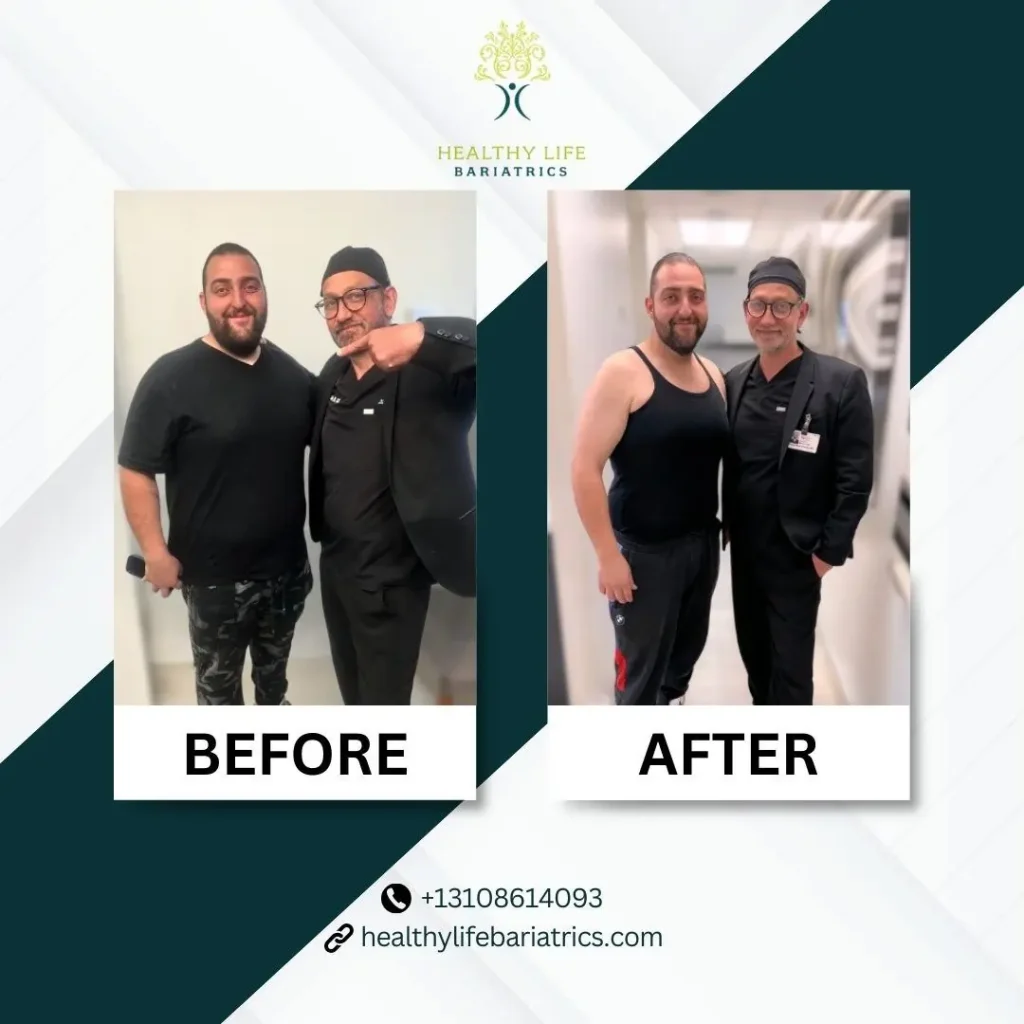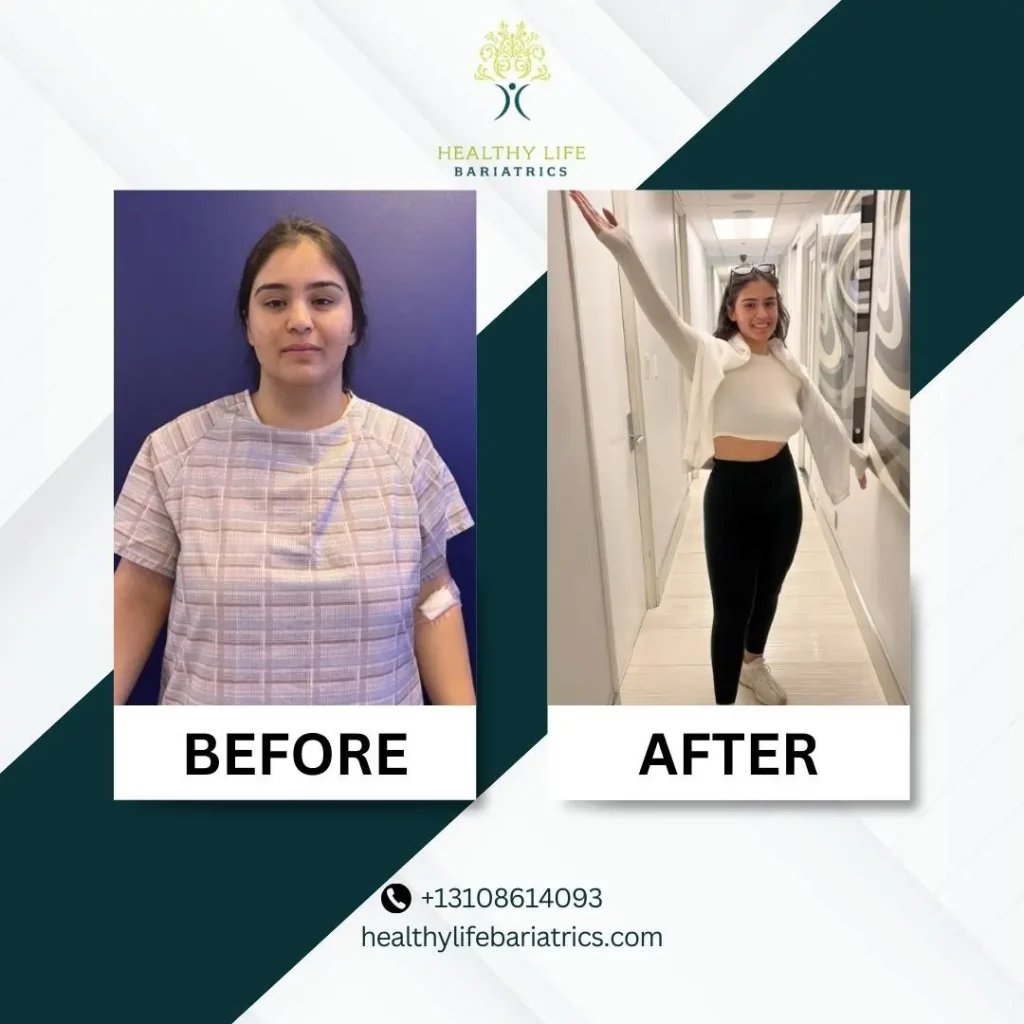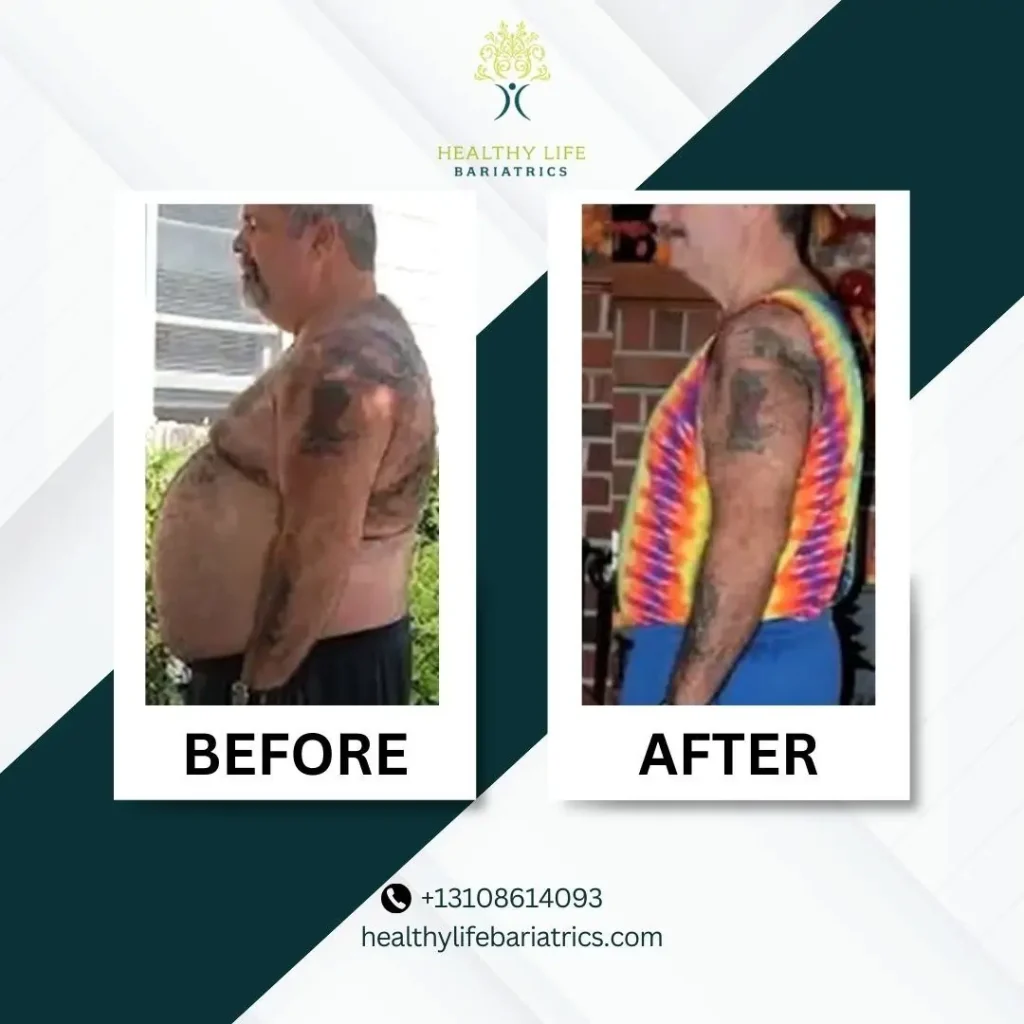
Gastric sleeve before and after is a transformative journey that requires understanding, preparation, and commitment. This weight loss surgery not only reshapes your stomach but also significantly impacts your lifestyle.
The benefits of gastric sleeve are tremendous. The positive effects are life-changing, from drastic weight loss to reduction in obesity-related health conditions such as high blood pressure and sleep apnea.



However, the gastric sleeve before and after experience has its challenges. It demands changes in eating habits, consistent exercise routines, and mental resilience.

Gastric sleeve surgery, often called sleeve gastrectomy, has become a popular choice for individuals seeking an effective solution for weight loss. This procedure involves reducing the stomach size by approximately 80%, resulting in a slim vertical “sleeve” shape resembling a banana.
The benefits of gastric sleeve surgery are numerous. Gastric sleeve surgery not only promotes significant weight loss but also helps to improve many obesity-related health issues. Many patients have reported noticeable changes before and after their surgeries.
Sleeve gastrectomy stands out for its simplicity compared to other bariatric procedures like gastric bypass, which involves modifying both the stomach size and the intestines’ structure. In contrast, gastric sleeve surgery primarily focuses on adjusting the dimensions of the stomach.
This straightforward alteration helps manage portions while allowing individuals to enjoy most foods, albeit in smaller quantities. This modification also reduces hunger signals sent from the gut to the brain by decreasing the production of ghrelin, known as the “hunger hormone,” after the operation.
The experiences shared by patients who have undergone gastric sleeve surgery provide valuable insights into its effectiveness. For example, Patient #8030 experienced significant weight loss after the surgery, losing 36 pounds and lowering their BMI from 34.4 to a healthier range of 29. Research has indicated that even modest weight reduction can greatly improve overall health.
Equally inspiring results were observed with Patient #7890, who lost an impressive 100 pounds, dramatically dropping BMI from 47.3 to just 33.5. Another noteworthy case is patient #7810, who lost over half their body weight at 115 pounds, bringing their BMI back within normal limits, dropping from 44 to 28.
As we delve into the next section, we will further explore how these remarkable transformations have resulted in significant weight loss and remarkable improvements in various obesity-related health conditions.



Gastric sleeve surgery is more than just a weight loss procedure. It is a pathway to significant health improvements, addressing excess pounds and obesity-related conditions.
The journey to recovery from obesity can be challenging, but gastric sleeve surgery makes it easier. This procedure is a lifeline for patients struggling with high blood pressure, often a precursor to heart disease.
Let’s talk about one of our patients in this transformative journey. He underwent a successful procedure, losing 36 pounds and reducing his BMI from 34.4 to 29, significantly lowering the risk of hypertension and other cardiovascular issues.
This surgical treatment has also proven effective against sleep apnea, another condition that affects obese individuals by disrupting their sleep patterns. Another patient experienced a remarkable weight loss of 100 pounds and decreased their BMI from an alarming 47.3 to a healthier range of 33.5, significantly improving the quality of their nocturnal rest periods.
Weight loss not only means lighter steps on the scale but also alleviates acid reflux issues commonly experienced by overweight individuals. Another patient, for instance, lost an impressive total of 115 pounds following gastric bypass surgery, reducing their BMI from a high figure in the mid-forties to a more desirable range. This improvement brings relief from acid reflux and its associated discomfort.
Gastric sleeve surgery offers a transformative journey, providing weight loss and significant health benefits. Patients can experience improved blood pressure, sleep apnea, and acid reflux, leading to a better quality of life and overall well-being.

Gastric sleeve surgery may seem daunting, but understanding its step-by-step process can make it far less intimidating. From mental preparation to dietary changes before surgery, let’s explain how you can effectively navigate this life-altering journey.
The first hurdle in your gastric sleeve journey is mental preparedness. You might wonder – How do I overcome my fears and anxieties? What kind of mindset should I adopt?
As content marketers develop repeatable strategies to tackle challenges, preparing mentally for surgical treatment involves establishing a clear plan that alleviates uncertainties and builds confidence.
Adequate research about the procedure or connecting with individuals who have undergone similar experiences are great ways to start. The objective is not simply to be aware of the process during surgery; it’s also about getting ready for after-surgery recuperation and way-of-life modifications.
The second phase requires physical readiness through dietary modifications. Just like high-quality content sets apart successful marketing campaigns, adhering strictly to pre-surgery diet guidelines is key in ensuring positive outcomes from your operation.
Your commitment towards these nutritional shifts will significantly contribute towards safer surgeries and faster recoveries post-op. All patients who underwent gastric sleeve surgery reported various degrees of weight loss after their operations.
Beyond losing pounds, mastering each stage of gastric sleeve prepares you for long-term success–from maintaining healthy eating habits consistent with those practiced pre-operation to adapting to an active lifestyle afterward.
We trust you found this info useful. Up next, we’re going to
The transformative power of gastric sleeve surgery is evident in the success stories of patients who have embarked on this journey. Each individual has a unique narrative, filled with determination and commitment to healthier living.
“After undergoing gastric sleeve surgery, I lost 24 lbs. It was challenging but rewarding as I regained control over my health.”
This remarkable transformation isn’t an isolated incident; many others share similar experiences. For instance, another patient shares:
“The procedure helped me lose an impressive 40 lbs. My story serves as motivation for those considering bariatric procedures.”

Gastric sleeve surgery can be life-changing; however, potential complications like blood clots or revision surgeries should not be overlooked.
“I achieved a staggering weight loss of 68.4 lbs after the operation,” says one determined patient (#6870). “But it’s important to understand that there are risks involved in any surgical procedure.”
Variations in side effects among individuals make thorough discussion crucial before opting for such interventions. The importance lies in achieving long-term positive outcomes regarding body weight management and overall wellness.

Understanding these health challenges can seem overwhelming, but by breaking them down, we find that they are quite manageable. Let’s explore the potential risks associated with gastric sleeve surgery.
Blood clots, an unfortunate risk linked to surgeries in general, are also a concern following gastric sleeve procedures. These clots could form due to extended bed rest or even obesity itself, which increases the likelihood of clot formation.
Sometimes, patients may require a follow-up operation, known as revision surgery. This may be necessary if complications arise from the initial procedure or if weight loss goals are not met as expected.
The aftermath of this surgical journey often includes various complications, such as infection, bleeding, leakage along the stomach’s staple line, and nutritional deficiencies. However, it is crucial not to view these as inevitable outcomes. Instead, consider them cautionary possibilities that should be extensively discussed with your healthcare provider before making any decisions.
Moving beyond immediate post-operative complications, there are long-term health risks that one needs to consider when contemplating this bariatric procedure. Heartburn, gastritis (inflammation within the stomach lining), hernias, and potentially worsened symptoms for those already dealing with gastroesophageal reflux disease (GERD) fall into this category.
These may be some of the consequences you could encounter.
So, it’s super important for folks who’ve had this big operation to pick up new ways of living.
Embracing lifestyle changes after gastric sleeve surgery is crucial for long-term weight management success. While the journey may seem daunting, the steps to follow are straightforward.
After the surgery, your stomach will hold less food. How can you manage this new situation? The key is to adjust your eating habits accordingly.
You’ll need to swap large meals for smaller portions throughout the day. Initially, it is recommended to avoid solid foods and start with liquids. Gradually, you can introduce soft foods as advised by your healthcare team. For comprehensive dietary guidelines tailored specifically for patients who have undergone procedures like gastric sleeve surgeries, you can refer to resources provided by Primary Care.
In addition to dietary changes, regular exercise plays a critical role in maintaining weight loss after the surgery. But what types of activities should you engage in?
It is important to avoid strenuous activities immediately following the procedure until your doctor clears you. Once approved, you can incorporate regular physical activity into your routine. Consider trying low-impact activities, such as walking or swimming, if you’re beginning.
To achieve effective weight management, it is essential to ensure that your diet provides the necessary nutrients and avoids those that could cause issues such as dumping syndrome. It goes beyond just counting calories; it’s about providing your body with the necessary nutrients while avoiding those that can lead to complications, such as dumping syndrome. Dumping syndrome is a common side effect where food moves too quickly through the digestive tract, causing symptoms like nausea or vomiting.
Ensure every meal includes nutrient-dense foods like lean proteins, fruits, and vegetables. Limit your intake of high-fat snacks and sugary drinks, as they can exacerbate these issues.
Life after bariatric surgery can feel like a maze, especially if you’re considering having the operation overseas. In our upcoming section, we’ll dig into what folks getting treatment internationally can look forward to.



When considering gastric sleeve surgery, it’s important to understand the transformative journey that lies ahead. This procedure can change lives, offering significant weight loss and improved health. Let’s explore the process, benefits, risks, and post-surgery lifestyle changes of gastric sleeve before and after.
This surgery involves reducing the stomach size, creating a smaller, sleeve-shaped pouch. This limits the amount of food consumed, leading to weight loss. The procedure is typically performed laparoscopically, using small incisions and a camera for guidance.
Before the surgery, patients undergo a thorough evaluation to ensure they are suitable candidates. This includes medical assessments, discussing expectations and goals, and consultations with a healthcare team.
Gastric sleeve surgery offers numerous benefits for individuals struggling with obesity. The most significant benefit is weight loss, which can be substantial and long-lasting. Substantial weight loss can lead to numerous improvements in overall health, including reduced risk of obesity-related diseases, increased mobility, and improved quality of life.
In addition to weight loss, gastric sleeve surgery can improve or resolve obesity-related conditions such as type 2 diabetes, high blood pressure, sleep apnea, and joint pain.



Many individuals have experienced life-changing results with gastric sleeve surgery. People who have undergone gastric sleeve surgery report remarkable outcomes, such as substantial weight loss, improved self-esteem, greater vitality, and an enhanced feeling of assurance. These stories serve as inspiration for those considering the procedure.
One success story is that of Sarah, who struggled with obesity for years. After undergoing gastric sleeve surgery, she lost over 100 pounds and regained her health. She now enjoys an active lifestyle, participates in activities she once couldn’t, and feels more confident in her skin.
Getting a gastric sleeve isn’t without risks, like any other surgery. You could face infections, bleeding, blood clots, or leaks from the staple line.
In the world of bariatrics, there are numerous ways you can contribute. One significant method is donating today to support ongoing research and development to enhance procedures like gastric sleeve surgeries.
The opportunity for individuals like yourself to make an impact in this field is vast. Despite seeming insignificant, your donation could be pivotal in pushing ahead with essential investigations into safer surgical processes, the long-term health of patients, and improved pre- and post-care.

Becoming part of the solution doesn’t merely involve spreading awareness; it means contributing directly towards its advancement. Your donation aids essential initiatives focusing on obesity risks and available treatments—helping us reach more people who need assistance most urgently while simultaneously advocating preventive measures among broader populations.
This proactive approach echoes what I’ve observed from my experience working with various organizations committed to combating obesity—it’s incredibly rewarding to see how individual contributions collectively lead to meaningful change within society.
Are you considering gastric sleeve surgery? Discover the transformative journey of gastric sleeve before and after. This life-changing procedure offers numerous benefits, including weight loss and improved overall health.
Following surgery, patients typically experience rapid weight loss. On average, individuals shed around 5 to 10 pounds per week, resulting in an impressive 20 to 40 pounds of weight loss within the first month.
The weight loss journey continues in the months following this surgery. Patients can expect to lose approximately 25% to 35% of their excess body weight within three months. This significant reduction not only improves physical appearance but also enhances overall well-being.
Long-term success is possible with gastric sleeve surgery, but it requires a commitment to a healthy lifestyle. After ten years, many patients maintain significant weight loss. However, it’s important to note that lifestyle habits and dietary choices are crucial in sustaining these results. By adopting a balanced diet and regular exercise, individuals can enjoy the benefits for years.

Embarking on the journey of this surgery is a transformative experience that reshapes your body and transforms your lifestyle.
This surgical procedure offers remarkable benefits, including weight loss and reduced obesity-related health conditions such as high blood pressure and sleep apnea.
However, it is crucial to thoroughly understand the entire process, from pre-surgery preparation to post-operative recovery. This knowledge empowers you to achieve long-term success in managing your weight.
Inspiring real-life stories serve as a reminder of what can be achieved through this medical intervention. It is important to consider the potential risks before making an informed decision about the procedure.
Adopting healthier eating habits and incorporating regular exercise into your lifestyle are essential changes after surgery. These changes will ensure sustained results over time.
If you are considering this life-changing step or seeking more information about this surgery, please visit Health Life Bariatrics.